 |
 |
|
 |
|
 |
|  |
|  |
|
 |
|
 |
|  |
|  |
|
 |
As I said, this is my first head modelling. Pretty good for a novice, isn't
it?
Cheers,
--
Jonathan
Post a reply to this message
Attachments:
Download 'dux.jpg' (84 KB)
Preview of image 'dux.jpg'
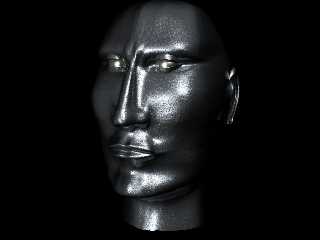
|
 |
|  |
|  |
|
 |
|
 |
|  |
|  |
|
 |
Nice.. good nose. I like the texture too. Could you post the source
for that?
sig
--
ICQ 74734588
Post a reply to this message
|
 |
|  |
|  |
|
 |
|
 |
|  |
|  |
|
 |
"Sigmund Kyrre Aas wrote
> Nice.. good nose. I like the texture too. Could you post the source
> for that?
>
> sig
Like that texture ... looks cast. Nice model too ... esp for a first.
--
Y
Post a reply to this message
|
 |
|  |
|  |
|
 |
|
 |
|  |
|  |
|
 |
"Sigmund Kyrre Aas" <as### [at] stud ntnu ntnu no> ha scritto nel messaggio
news:82btnt861hc03s3j0jlfnu5r43s6porghd@4ax.com...
> Nice.. good nose. I like the texture too. Could you post the source
> for that?
The texture for the skin is T_Chrome_2D from my personal new_metals.inc, a
heavy modified version of the standard metals.inc. Anyway here's the source:
#declare P_Chrome2 = color rgb <0.39, 0.41,
0.43>/vlength(<0.39,0.41,0.43>)*sqrt(3*0.8);
#declare F_MetalD =
finish {
ambient 0.0
brilliance 5
diffuse 0.3
metallic
specular 1.2
roughness 0.015
}
#declare T_Chrome_2D = texture { pigment { P_Chrome2 } finish { F_MetalD
reflection 0.7*P_Chrome2} }
Then I added a simple normal to get the *skin effect*...
#declare T_Skin = texture {T_Chrome_2D normal { granite -0.3 scale 0.1
cubic_wave }}
Note that the negative bumpiness is needed if you want to get that very
effect.
Regards,
--
Jonathan no> ha scritto nel messaggio
news:82btnt861hc03s3j0jlfnu5r43s6porghd@4ax.com...
> Nice.. good nose. I like the texture too. Could you post the source
> for that?
The texture for the skin is T_Chrome_2D from my personal new_metals.inc, a
heavy modified version of the standard metals.inc. Anyway here's the source:
#declare P_Chrome2 = color rgb <0.39, 0.41,
0.43>/vlength(<0.39,0.41,0.43>)*sqrt(3*0.8);
#declare F_MetalD =
finish {
ambient 0.0
brilliance 5
diffuse 0.3
metallic
specular 1.2
roughness 0.015
}
#declare T_Chrome_2D = texture { pigment { P_Chrome2 } finish { F_MetalD
reflection 0.7*P_Chrome2} }
Then I added a simple normal to get the *skin effect*...
#declare T_Skin = texture {T_Chrome_2D normal { granite -0.3 scale 0.1
cubic_wave }}
Note that the negative bumpiness is needed if you want to get that very
effect.
Regards,
--
Jonathan
Post a reply to this message
|
 |
|  |
|  |
|
 |
|
 |
|  |
|  |
|
 |
> The texture for the skin is T_Chrome_2D from my personal new_metals.inc, a
> heavy modified version of the standard metals.inc. Anyway here's the source:
> Regards,
> --
> Jonathan
>
I thank you sir . . . will go put it on something right now.
Also the first entry into my JBGMetals.inc . . . ;)
Any others you are willing to share will go there too.
Thanks . . .
--
Y
Post a reply to this message
|
 |
|  |
|  |
|
 |
|
 |
|  |
|  |
|
 |
> #declare P_Chrome2 = color rgb <0.39, 0.41,
0.43>/vlength(<0.39,0.41,0.43>)*sqrt(3*0.8);
> --
> Jonathan
I'm confused about /vlength(<0.39,0.41,0.43>)*sqrt(3*0.8);
and what you are using it to accomplish. I understand you are
altering the rgb but I don't know why you are using vlength to
do it.
Wouldn't this be like color rgb <0.645,0.645,0.645>
Just curious . . . and wondering what I'm missing.
--
Y
Post a reply to this message
|
 |
|  |
|  |
|
 |
|
 |
|  |
|  |
|
 |
I began modifying the finish definitions of the standard metals.inc. The
pigment were right to me, but they looked really too dark with the new
finishes. So I normalized every color vector ( < r, g, b > / vlength (< r,
g, b > ) ) and then I multiplied it by sqrt(3) in order to get every color
vector as bright as <1,1,1> ( if a normalized vector is one unit long and
you multiply it by sqrt (3) you have a color vector as long (i.e. bright) as
<1,1,1> since vlength (<1,1,1>) = sqrt ( 1^2 + 1^2 + 1^2) = sqrt (3)). Then
I lowered each value to get the right brightness. Here follow some (badly
compressed :-\ ) examples. As an aside, if you want the whole .inc file
just ask.
Cheers,
--
Jonathan.
Post a reply to this message
Attachments:
Download 'brasses.jpg' (74 KB)
Download 'chromes.jpg' (69 KB)
Download 'coppers.jpg' (70 KB)
Download 'golds.jpg' (75 KB)
Download 'silvers.jpg' (72 KB)
Preview of image 'brasses.jpg'
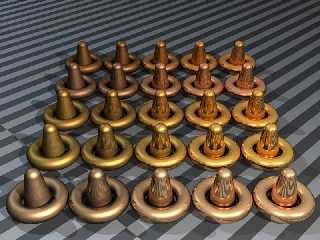
Preview of image 'chromes.jpg'
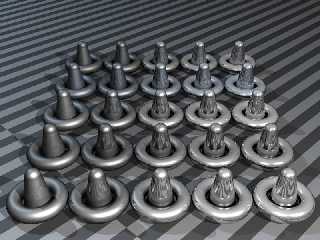
Preview of image 'coppers.jpg'
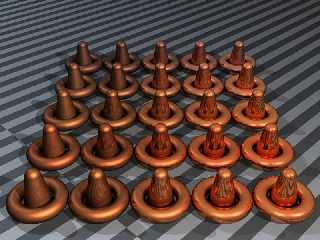
Preview of image 'golds.jpg'
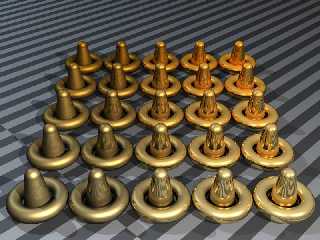
Preview of image 'silvers.jpg'
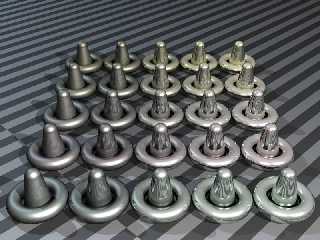
|
 |
|  |
|  |
|
 |
|
 |
|  |
|  |
|
 |
> I began modifying the finish definitions of the standard metals.inc. The
> pigment were right to me, but they looked really too dark with the new
> finishes. So I normalized every color vector ( < r, g, b > / vlength (< r,
> g, b > ) ) and then I multiplied it by sqrt(3) in order to get every color
> vector as bright as <1,1,1> ( if a normalized vector is one unit long and
> you multiply it by sqrt (3) you have a color vector as long (i.e. bright) as
> <1,1,1> since vlength (<1,1,1>) = sqrt ( 1^2 + 1^2 + 1^2) = sqrt (3)). Then
> I lowered each value to get the right brightness. Here follow some (badly
> compressed :-\ ) examples. As an aside, if you want the whole .inc file
> just ask.
> Cheers,
>
> --
> Jonathan.
>
OK ... I just don't see the difference in doing that and simply
multipling <r,g,b> by some factor greater than one to increase
brightness. I guess your method makes it more consistant . . . as
you begin with <1,1,1> regardless of the pigment shade and the
value you use - sqrt(3*x) - gives the relative brightness.
If you will share your inc file, perhaps I'll be able to see what
you are doing by comparing a few of them and working with them
until I can "see" it ;)
Nice example scene . . .
Thanks . . .
--
Y
Post a reply to this message
|
 |
|  |
|  |
|
 |
|
 |
|  |
|  |
|
 |
Fantastic! I have saved the sample images, and if you could post the source
for your include file I will start using it in all my projects. Thanks.
"JRG" <jrg### [at] hotmail com> wrote in message
news:3b80d15f@news.povray.org...
> I began modifying the finish definitions of the standard metals.inc. The
> pigment were right to me, but they looked really too dark with the new
> finishes. So I normalized every color vector ( < r, g, b > / vlength (< r,
> g, b > ) ) and then I multiplied it by sqrt(3) in order to get every color
> vector as bright as <1,1,1> ( if a normalized vector is one unit long and
> you multiply it by sqrt (3) you have a color vector as long (i.e. bright)
as
> <1,1,1> since vlength (<1,1,1>) = sqrt ( 1^2 + 1^2 + 1^2) = sqrt (3)).
Then
> I lowered each value to get the right brightness. Here follow some (badly
> compressed :-\ ) examples. As an aside, if you want the whole .inc file
> just ask.
> Cheers,
>
> --
> Jonathan.
>
>
>
>
>
>
> com> wrote in message
news:3b80d15f@news.povray.org...
> I began modifying the finish definitions of the standard metals.inc. The
> pigment were right to me, but they looked really too dark with the new
> finishes. So I normalized every color vector ( < r, g, b > / vlength (< r,
> g, b > ) ) and then I multiplied it by sqrt(3) in order to get every color
> vector as bright as <1,1,1> ( if a normalized vector is one unit long and
> you multiply it by sqrt (3) you have a color vector as long (i.e. bright)
as
> <1,1,1> since vlength (<1,1,1>) = sqrt ( 1^2 + 1^2 + 1^2) = sqrt (3)).
Then
> I lowered each value to get the right brightness. Here follow some (badly
> compressed :-\ ) examples. As an aside, if you want the whole .inc file
> just ask.
> Cheers,
>
> --
> Jonathan.
>
>
>
>
>
>
>
Post a reply to this message
|
 |
|  |
|  |
|
 |
|
 |
|  |
|  |
|
 |
Hi Spock,
I tried to send you the file by mail, but recieved a 'delivery status
notification (failure)'. Maybe your address is not correct... :-\
Post a reply to this message
|
 |
|  |
|  |
|
 |
|
 |
|  |




![]()